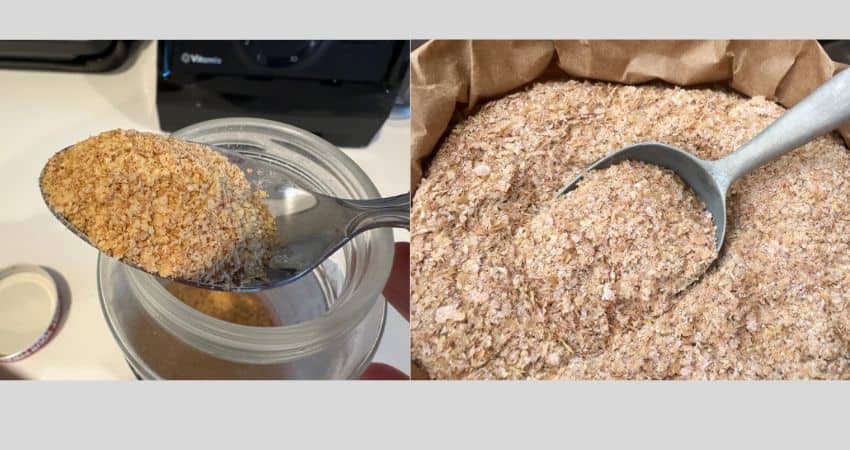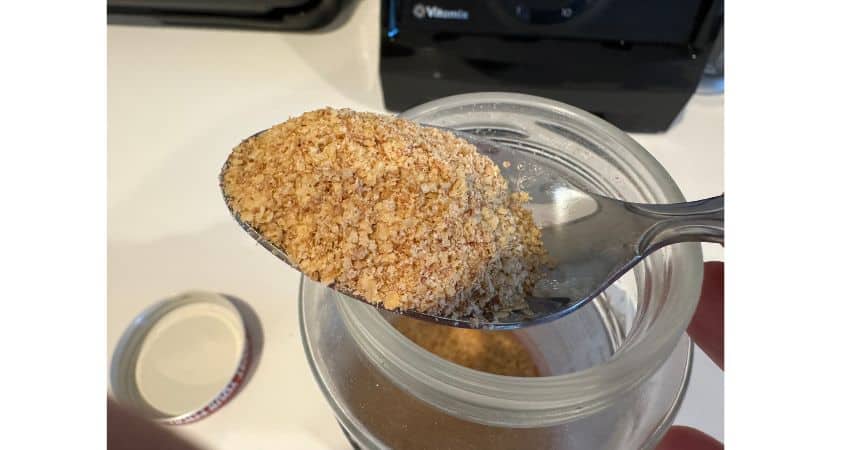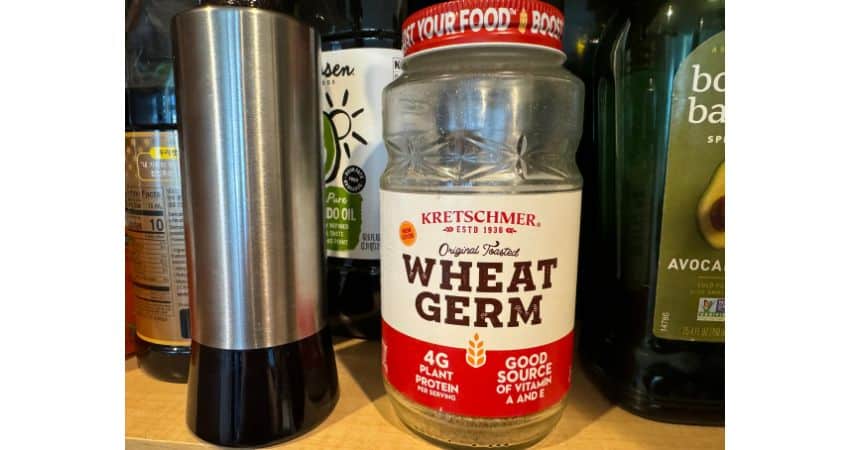Wheat Germ vs. Wheat Bran: What’s The Difference?
Wheat germ and wheat bran are two separate parts of a whole, with the third part being the endosperm. Together, they make up the kernel or seed of the wheat plant. The whole grain kernel is protected while growing in the field by the outer husk of the wheat plant.
The primary difference between wheat germ and wheat bran is the part of the wheat plant that is ground and harvested. Wheat bran is made from the outer layer of the wheat kernel, while wheat germ is found inside the plant’s endosperm. They also differ in nutrition contents and texture.
As a Certified Health Coach many clients ask me about food comparisons including wheat germ and bran. Therefore, I have researched this topic in the past and present. I also consume both of them in my diet. Let’s examine them.
What Part of the Wheat Plant Does Wheat Bran Come From?

Wheat bran comes from the tough outer layer of the wheat plant’s kernel. When the grain is milled, the bran is separated out. It’s considered a by-product of wheat, but it’s not discarded.
After the bran is ground, it’s used as an additive to some commercially prepared foods like cereals, flours and baked goods1.
You can purchase wheat bran separately for use at home. Some people sprinkle it in foods like cereals or smoothies for a nutritional boost with a few added fat and calories.
Nutritional Benefits of Wheat Bran
One-half cup of wheat bran will add 4.5 grams (0.15 oz) of protein along with thiamine, niacin, potassium, magnesium, phosphorus, B6, thiamin, riboflavin and iron. Small amounts of zinc, copper and selenium are also present2.
All that for only 63 calories and less than 2 grams (0.07 oz) of fat.
Wheat bran is most famous for the dietary fiber it contains. The American Heart Association suggests 25 grams (0.88 oz) of fiber per day to help maintain heart health3 .
One-half cup contains 12.5 grams (0.44 oz), or half, of the daily requirement of water-soluble fiber.
A diet high in fiber aids in digestive health by adding bulk to stools and prebiotics to maintain gut health. A high fiber diet is associated with lower rates of colon cancer4.
Antioxidants in wheat bran support our immune systems by helping to block the formation of cancerous cells. Some see a decrease in total cholesterol after adding more fiber to their diet. In addition, fiber helps promote heart health.
The Downsides of Wheat Bran
The many health benefits found in wheat bran are sound except for those who cannot process the proteins known as glutens. Those who are gluten sensitive or diagnosed with celiac disease need to avoid wheat bran.
Others interested in adding nutritional boosters and more fiber to their diet will find wheat bran a good source. However, to avoid gastric discomfort, add fiber slowly and gradually until your body adapts to the extra fiber.
Wheat bran is also high in fructans, which are a carbohydrate. Those with IBS (irritable bowel syndrome) will want to avoid wheat bran because their digestive system does not process these carbohydrates efficiently.
What Part of the Wheat Plant Does Wheat Germ Come From?

Wheat germ comes from the plant’s endosperm. Referred to as the heart of the wheat berry, wheat germ is considered the wheat plant’s embryo and is responsible for promoting the growth of new wheat plants. During production, it’s separated and ground into flakes.
The wheat plant is topped by wavy spikes that contain wheat berries.
Take away the husk and the outer bran layers, and you’ll find the endosperm. The endosperm is the food source for wheat berries. Tucked in the endosperm is the wheat germ.
Nutritional Benefits of Wheat Germ
Wheat germ is chock-full of B vitamins, minerals, healthy fats and a small amount of protein. It’s a nutritious addition to your daily diet5.
Wheat germ is a nutritious food supplement that can be added to just about any type of food6. The small golden flakes tend to have a nutty taste and are frequently sprinkled into smoothies, on top of fruit or mixed with yogurt. Just today I added some wheat germ to my smoothie.
Two tablespoons of wheat germ sprinkled into cereal, soup or meatloaf will add only 45 calories and 1 gram (0.03 oz) of fat7.
Can Wheat Germ be Bad for You?
Wheat germ contains gluten, which can be bad for you and cause inflammation if you have a gluten intolerance or irritable bowel syndrome.
Wheat germ also contains fats beneficial in moderation, but consuming too much can increase your overall calorie intake and affect your diet’s balance.
Wheat germ does have a lower fiber content than wheat bran, making it slightly easier to digest for some. However, if you avoid eating wheat bran because of an intolerance, then you should probably refrain from eating wheat germ too.

Wheat Bran and Wheat Germ Nutrient Content
The vitamin and mineral content of wheat bran and wheat germ are similar.
| Wheat Germ (2 Tbsp) |
Wheat Bran (2 Tbsp) |
|
| Calories | 54 | 32 |
| Fat | 1.5 g | 0.6 g |
| Carbohydrates | 7.8 g | 9.7 g |
| Protein | 3.5 g | 2.3 g |
| Fiber | 2.0 g | 6.4 g |
| Calcium | 5.85 mg | 10.95 mg |
| Iron | 0.94 mg | 1.59 mg |
| Potassium | 134 mg | 177 mg |
| Magnesium | 35.85 mg | 91.65 mg |
| Manganese | 1.995 mg | 1.725 mg |
| Phosphorus | 126.30 mg | 151.95 mg |
| Selenium | 11.9 mcg | 11.6 mcg |
| Zinc | 1.84 mg | 1.09 mg |
| Folate | 42.15 mcg | 11.85 mcg |
| Niacin | 1.022 mg | 2.037 mg |
| Thiamin | 0.282 mg | 0.078 mg |
| B6 | 0.195 mg | 0.195 mg |
Examining the table above, which is healthier wheat bran or wheat germ? Wheat bran is healthier than wheat germ because it has less calories and contains more fiber, calcium, iron, potassium, magnesium, phosphorus and niacin per serving than what germ.
Although wheat germ provides a good number of these nutrients as well. Wheat germ contains more zinc, folate and protein. If you want to boost your fiber significantly, then wheat bran is an efficient and effective way to do that. However, wheat germ is more easily digestible.
Are Wheat Bran and Wheat Germ Considered Whole Grains?
Wheat bran and wheat germ are not individually considered whole grains because they are separated from the wheat berry during production. Instead, whole grain wheat products utilize the entire wheat berry or kernel, which includes bran, germ and endosperm.
The three parts of the wheat berry are kept whole to make whole grain products, like cereal and flour ((Bob’s Red Mill: Wheat Bran vs Wheat Germ: What’s the Difference?)).
How Is the Wheat Plant’s Endosperm Used?
The wheat plant’s endosperm is typically used to make white flour. The endosperm surrounds the wheat germ and is ground into a fine powder during production. The endosperm is also rich in vitamins and minerals.
However, when the endosperm, bran and germ are all kept intact and ground together, they produce whole grain flour instead of white flour.
Find out how peanuts compared to almonds in my article, Peanuts vs Almonds: Which is Healthier? Let’s Compare.
Disclaimer: Some links in this article are affiliate links which means I may earn a small commission at no extra cost to you. As an Amazon associate I earn from qualifying purchases.
Wheat Germ vs Wheat Bran: The Cost
Wheat bran costs more than wheat germ. Wheat bran cost 0.20 cents per serving and wheat germ cost 0.18 cents per serving. Consuming one serving per day for a whole month, wheat bran will cost 0.60 cents more per month.
Surprisingly, the cost is not much of a difference. This is great news for whichever product you choose. I priced each one at a local Walmart and divided the total cost by serving to find the answer.
Both products are difficult to find in the local supermarket. I have better luck finding wheat germ in the cereal isle but it’s often hidden on a shelf somewhere.
Amazon sells both of them at comparable prices. Check out the current price here, Wheat Germ and Wheat Bran.
If you have any questions to ask me about this article don’t hesitate to comment below or email us. You can find an email on our contact page.
Read Next – More Food vs Food Articles!
Ground Flaxseed vs Flaxseed Meal: The Differences
Organic Eggs Vs Pasture Eggs: A Comparison
Oatmeal Vs. Oat Bran: A Comparison
Collard Greens Vs Turnip Greens: Which is Better?
Raspberries Vs Strawberries – Nutrition To Storage And More
- ScienceDirect: Wheat Bran and Wheat Germ [↩]
- Nutrition Value: Wheat bran [↩]
- American Heart Association: Whole Grains, Refined Grains, and Dietary Fiber [↩]
- National Center for Biotechnology Information: Wheat bran: its composition and benefits to health. a European perspective [↩]
- National Center for Biotechnology Information: Can wheat germ have a beneficial effect on human health? A study protocol for a randomized crossover controlled trial to evaluate its health effects [↩]
- Bob’s Red Mill: What Is Wheat Germ and Why Should I Be Eating It? [↩]
- Nutrition Value: Wheat germ [↩]
